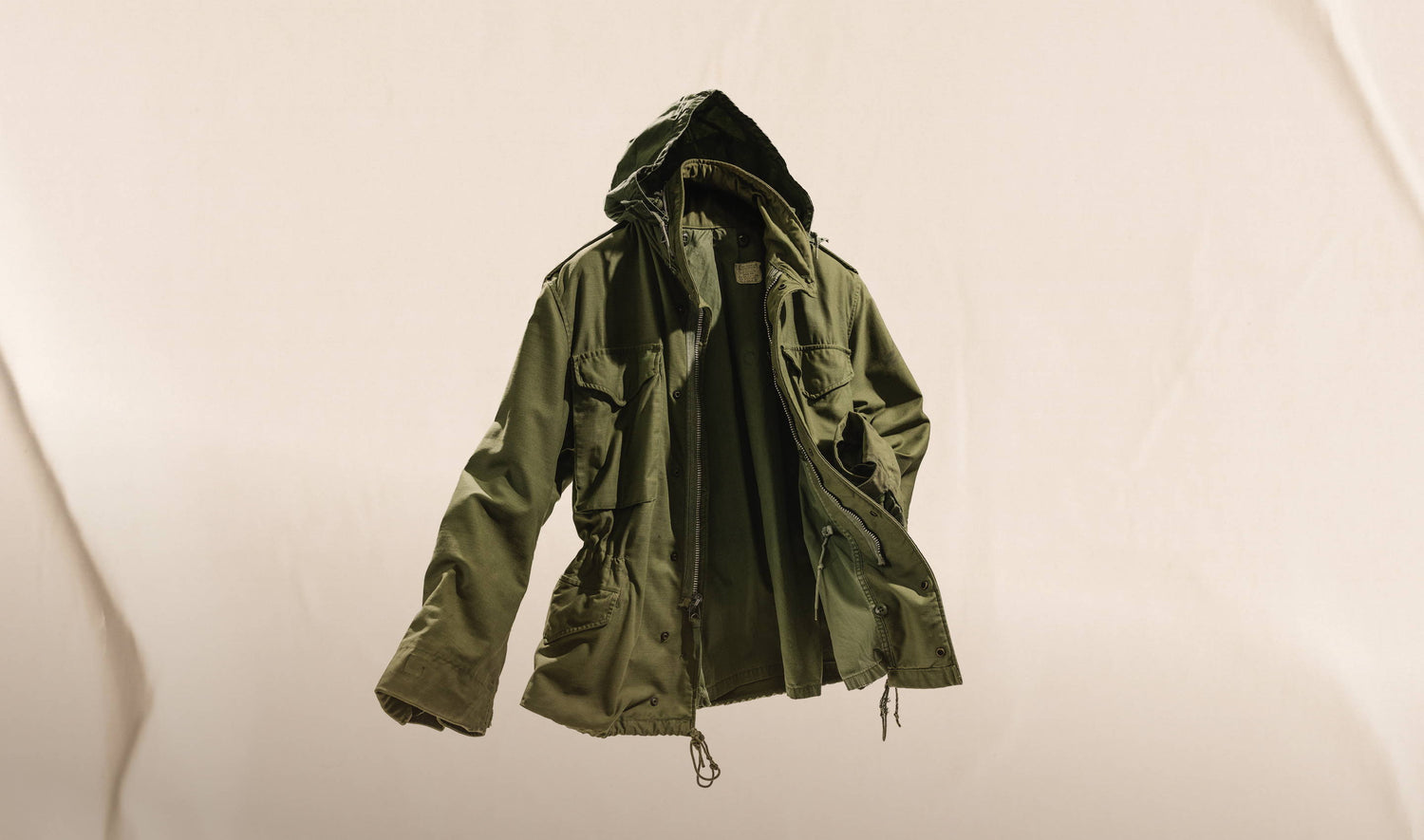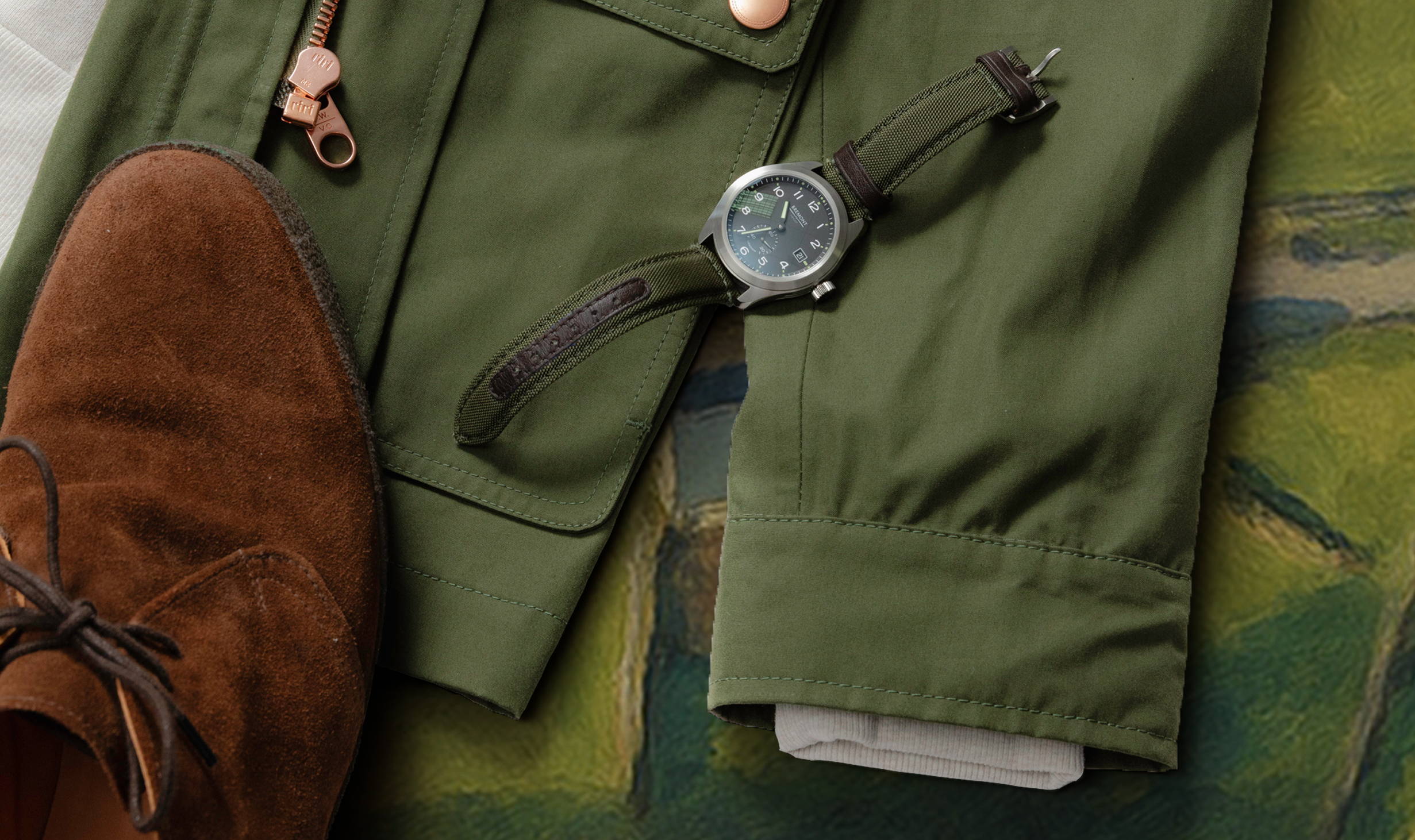Into the Archive: The Field Jacket Has Come A Long Way
The field jacket has long outlived its original military purpose, becoming a lasting icon of utility, durability, and effortless cool. Its lineage can be traced back to the M-43, issued by the U.S. Army during the Second World War, which introduced a longer cut, improved insulation, and more functional pockets, addressing the shortcomings of the earlier M-41.
The M-51 followed in the early 1950s, refining the design with the use of cotton sateen fabric, stud fastenings, and a more effective hood system. Then came the now-legendary M-65, first issued in 1965 and manufactured by Alpha Industries in Tennessee. Designed to withstand the punishing terrain and climate of Vietnam, it quickly became the most iconic field jacket of them all.
The M-41 jacket During WWII
Built for combat, the M-65 featured a durable nylon-cotton sateen shell, a concealed rollaway hood, and four oversized bellows pockets, engineered to handle monsoons, jungle thickets, and unpredictable conditions. It spawned countless variants over time: stud-in liners, wool and sheepskin inserts, detachable cold-weather hoods, and even down-filled versions.
Adopted by anti-war protestors, artists, and musicians, it became a symbol of counterculture, disillusionment, and rebellion. John Kerry wore one while denouncing the war he had just fought in. So did John Lennon, Jane Fonda, and thousands of others who reappropriated military surplus as a uniform of protest and peace.
(Left) Jane Fonda Wearing the Field Jacket. New York, 1971, (Right) Anti-Vietnam-war protest. Washington DC, October 1969
Hollywood took notice. The M-65 became the on-screen uniform of post-war masculinity and urban defiance, De Niro in ‘Taxi Driver’, Pacino in ‘Serpico’, Stallone in ‘Rambo’.
Robert De Niro in "Taxi Driver" (1976)
The field jacket has since inspired countless iterations and reinterpretations, evolving into a design language of its own and establishing itself as undoubtedly one of the most influential garments in menswear history. The design has been reinterpreted around the world, from luxury fashion houses to high street brands, but few know the field jacket like we do.
Over the years, our Manchester factory has proudly produced field jackets for at least four national armed forces, including Britain, Sweden, and Spain – each with its own exacting technical standards and unique climatic demands.
Manchester-made, Military-grade
Given its global popularity and cultural significance, it's no surprise that we’ve continued to evolve and refine the field jacket - today offering two distinct interpretations for modern life. Both are constructed from our exclusive UK-woven military-grade ripstop – durable, breathable, water-repellent, and battle-tested. Just as every proper field jacket should be.
Into the Archive: The Field Jacket Has Come A Long Way
The field jacket has long outlived its original military purpose, becoming a lasting icon of utility, durability, and effortless cool. Its lineage can be traced back to the M-43, issued by the U.S. Army during the Second World War, which introduced a longer cut, improved insulation, and more functional pockets, addressing the shortcomings of the earlier M-41.
The M-51 followed in the early 1950s, refining the design with the use of cotton sateen fabric, stud fastenings, and a more effective hood system. Then came the now-legendary M-65, first issued in 1965 and manufactured by Alpha Industries in Tennessee. Designed to withstand the punishing terrain and climate of Vietnam, it quickly became the most iconic field jacket of them all.
The M-41 jacket During WWII
Built for combat, the M-65 featured a durable nylon-cotton sateen shell, a concealed rollaway hood, and four oversized bellows pockets, engineered to handle monsoons, jungle thickets, and unpredictable conditions. It spawned countless variants over time: stud-in liners, wool and sheepskin inserts, detachable cold-weather hoods, and even down-filled versions.
The M-65 became a year-round staple of the U.S. military uniform, and, soon crossed over into civilian life. When American troops returned home, so did their jackets. But the M-65 quickly took on a new identity.
Adopted by anti-war protestors, artists, and musicians, it became a symbol of counterculture, disillusionment, and rebellion. John Kerry wore one while denouncing the war he had just fought in. So did John Lennon, Jane Fonda, and thousands of others who reappropriated military surplus as a uniform of protest and peace.
Jane Fonda Wearing the Field Jacket. New York, 1971.
Anti-Vietnam-war protest. Washington DC, October 1969
Hollywood took notice. The M-65 became the on-screen uniform of post-war masculinity and urban defiance, De Niro in ‘Taxi Driver’, Pacino in ‘Serpico’, Stallone in ‘Rambo’.
Robert De Niro in "Taxi Driver" (1976)
The field jacket has since inspired countless iterations and reinterpretations, evolving into a design language of its own and establishing itself as undoubtedly one of the most influential garments in menswear history. The design has been reinterpreted around the world, from luxury fashion houses to high street brands, but few know the field jacket like we do.
Over the years, our Manchester factory has proudly produced field jackets for at least four national armed forces, including Britain, Sweden, and Spain – each with its own exacting technical standards and unique climatic demands.
Manchester-made, Military-grade
Given its global popularity and cultural significance, it's no surprise that we’ve continued to evolve and refine the field jacket - today offering two distinct interpretations for modern life. Both are constructed from our exclusive UK-woven military-grade ripstop – durable, breathable, water-repellent, and battle-tested. Just as every proper field jacket should be.





Leave a comment
This site is protected by hCaptcha and the hCaptcha Privacy Policy and Terms of Service apply.